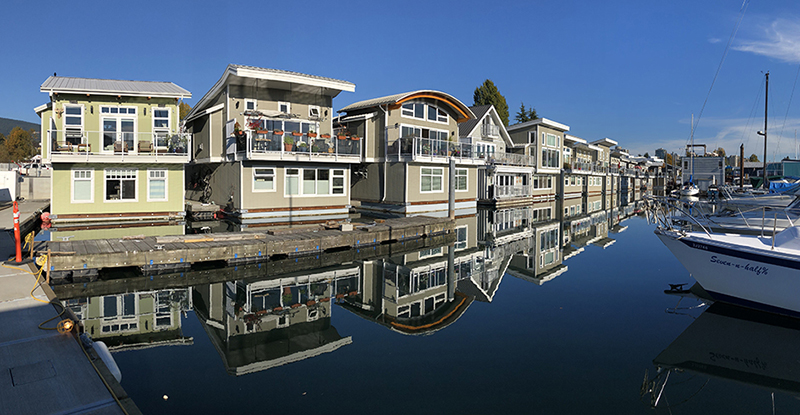
We’re surrounded by water in the form of rivers, oceans, and lakes in the Lower Mainland. Water actually covers 71% of our Earth's surface. Here in Metro Vancouver, our land has natural and planned boundaries where homes can’t be built, such as parks and the agricultural land reserve. We’re also hemmed in by mountains, the US border, as well as our waterbodies.
Are we ignoring our abundant supply of water that can offer more affordable home options in desirable locations? I’m not talking about a derelict sailboat bobbing on anchor in False Creek.
Float homes are one solution that feature truly waterfront living with ocean or river views at a fraction of the price. Neighbours include herons, sea lions, bald eagles, and many other forms of wildlife. While this style of living may not be for everyone, they do come in single family, apartments/condos, custom built, or modular, pre-fabricated options. New models include the usual home amenities such as stainless steel appliances, heated floors, soaker tubs, on-demand water heaters, and rooftop decks, and follow stringent building codes, fire safety, and environmental standards demanded by local, provincial, and federal authorities.
Property taxes for float homes will vary among municipalities. However, float home owners can expect to pay moorage fees, which are similar to strata fees. These fees cover the cost of water supply, waste disposal, and general upkeep of the marina. However, the reduced costs of owning a float home versus a traditional land-based home are still substantial. This price reduction is especially significant to aspiring homeowners in Metro Vancouver, as CPABC’s annual BC Check-Up report found that at 80.6%, Vancouver’s affordability index shows that a typical household earning median income in Greater Vancouver will need to spend 80.6% of their earnings on the cost of housing.
Locally, we already see charming, floating communities in Granville Island, Mosquito Creek Marina, Coal Harbour, Ladner, Richmond, Langley, and Queensborough. They also exist in other remote BC locations and abroad. Billed as a “Secret Sea Village”, established in the 1960s, Granville Island’s tiny enclave of float homes rarely have resales.
Seattle has float homes on Lake Union dating back to about 1895. Not to be outdone, New York City is planning a float home community of 19 high-rises, 29 to 138 metres, on Manhattan’s Pier 40, with 450 living units, for all budgets. Serbia offers floating apartments and hotel rooms on the Danube River. The City of Amsterdam describes “IJburg”, their floating home community currently under construction, as a project that will see 18,000 homes for 45,000 people, along with schools, shops, and restaurants. Proponents call this a solution to rising sea levels and flooding related to climate change. Richmond, which also faces similar flooding concerns, might want to research this option. The rising sea level threat was recently featured at a Urban Development Institute educational seminar for local home builders and other community-planning experts.
While a rising tide floats all boats, how exactly do these homes stay afloat? They rely on a concrete pad filled with dense Styrofoam, moored within a marina. Although they can’t be driven like a boat, they are portable and can be towed to other locations. Using the latest engineering and innovation, newer models are more self-sustaining, with solar panels, and a built-in sewage treatment plant that discharges clean water while older homes still require daily waste removal service. Communities on water can be more densely constructed and still stay clear of commercial shipping lanes.
Recently, a local realtor who specializes in float homes was showing an older, one bedroom, one bath with 633 square feet of living space for $159,000 in Richmond Marina, not including associated sales, property taxes and marina fees. A 4-bedroom, 2.5-baths, 2,250 sq. ft. home at Richmond’s Rivers Bend Marina, advertised at $399,000, just sold. No, there isn’t missing a zero in the price. In North Vancouver, steps to the newly open Spirit Trail, SeaBus, and Lonsdale Quay, a new, 1 bedroom plus loft, 1 bath, 575 sq.ft. is $559,900, built by the entrepreneurial Squamish Nation Marine Group. They’ve been in the float home-building business for ten years.
Yet these homes face the typical challenges that exist in constructing land-based apartments. Those are zoning hurdles, opposing politics, and multiple layers of bureaucratic, red tape. Without a real ‘sea change’ in public policy to accept more of these home choices, we’ll continue underusing our local waterways. These homes are ideal for people who love marine air and gentle waves, in a community that clearly welcomes landlubbers.
Anne McMullin is President & CEO of the Urban Development Institute, a non-profit and non-partisan industry association of the residential, commercial and industrial builders. This sector supports more than 220,000 good-paying, family-supporting BC jobs through nearly $23 billion in annual economic activity. Through municipal fees and contributions, the industry builds homes, offices, daycares, social housing, parks, public art, museums, schools and community centers throughout BC.
Originally published in Westcoast Homes & Design, Vancouver Sun.



